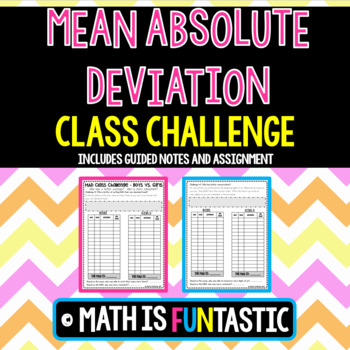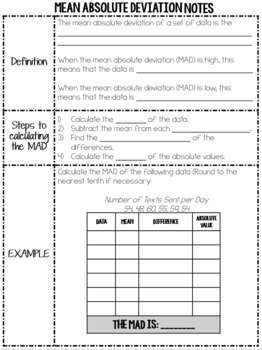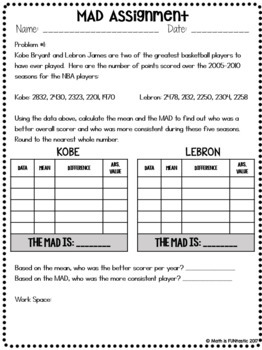Mean Absolute Deviation - Class Challenge
Math is FUNtastic
937 Followers
Grade Levels
6th - 9th
Subjects
Resource Type
Standards
CCSS6.SP.B.5
CCSS7.SP.B.3
CCSS7.SP.B.4
Formats Included
- PDF
Pages
6 student pages plus answer keys
Math is FUNtastic
937 Followers
What educators are saying
This is a new concept for 6th graders. This was great to use as a way to get some extra practice after the students learned how to find the MAD.
LOVE THIS ACTIVITY! MAD is not something students can relate to or understand until they use it in an authentic environment. This resource provides context for that understanding and is super fun and engaging for the kiddos.
Description
Are you looking for an engaging way to teach Mean Absolute Deviation? Look no further! My students love completing this lesson.
This product is designed to help your students master the MAD in three easy steps.
1) Guided Notes – The guided notes contain an introduction to calculating MAD. Students will write the overall meaning of the MAD and the steps to calculating. There is an example problem for the teacher to model and then two “you try” problems for students to try independently and check whole group.
2) Class Challenge – My students love competitions! In order to make the MAD more engaging, I have designed two class challenges in which the boys compete against the girls.
Challenge 1 – Students will write their names as many times as they can within one minute using their non-dominant hand. Students will then calculate the mean and MAD for both the boys and girls. They will then compare the data to determine who had a better overall average (mean) and who was more consistent in their variations (MAD).
Challenge 2 – In one minute, students will try to memorize as many digits of Pi as they can. Students will once again calculate the mean and the MAD to determine who had a better overall average (mean) and who was more consistent in their memorization (MAD).
3) Assignment – Students will calculate the MAD of real life data to compare athletes. (Basketball: Kobe Bryant vs. Lebron James & Soccer: Lionel Messi vs. Cristiano Ronaldo).
You might also be interested in:
• 7th Grade Math Bell Ringers, Warm-Ups, Exit Tickets
• 7th Grade Math Quick Color Bundle
• Compound Probability Bundle
• Cross Sections of 3D Figures Quick Color
• Equivalent Expressions -Distributive Property & Combining Like Terms Coloring
• Inequality Investigation: When to Reverse the Symbol
• Operations with Rational Numbers - Road Trip Application
• Proportional Relationships Tournament Challenge
• Solving Equations Tournament Challenge
• Theoretical and Experimental Probability Error Analysis
Be the first to know about the newest products and promotions. Follow Math is FUNtastic by clicking the green star above!
©️Math is FUNtastic 2018
This purchase is for one teacher only. Additional licenses are available at a discounted price.
This product is designed to help your students master the MAD in three easy steps.
1) Guided Notes – The guided notes contain an introduction to calculating MAD. Students will write the overall meaning of the MAD and the steps to calculating. There is an example problem for the teacher to model and then two “you try” problems for students to try independently and check whole group.
2) Class Challenge – My students love competitions! In order to make the MAD more engaging, I have designed two class challenges in which the boys compete against the girls.
Challenge 1 – Students will write their names as many times as they can within one minute using their non-dominant hand. Students will then calculate the mean and MAD for both the boys and girls. They will then compare the data to determine who had a better overall average (mean) and who was more consistent in their variations (MAD).
Challenge 2 – In one minute, students will try to memorize as many digits of Pi as they can. Students will once again calculate the mean and the MAD to determine who had a better overall average (mean) and who was more consistent in their memorization (MAD).
3) Assignment – Students will calculate the MAD of real life data to compare athletes. (Basketball: Kobe Bryant vs. Lebron James & Soccer: Lionel Messi vs. Cristiano Ronaldo).
You might also be interested in:
• 7th Grade Math Bell Ringers, Warm-Ups, Exit Tickets
• 7th Grade Math Quick Color Bundle
• Compound Probability Bundle
• Cross Sections of 3D Figures Quick Color
• Equivalent Expressions -Distributive Property & Combining Like Terms Coloring
• Inequality Investigation: When to Reverse the Symbol
• Operations with Rational Numbers - Road Trip Application
• Proportional Relationships Tournament Challenge
• Solving Equations Tournament Challenge
• Theoretical and Experimental Probability Error Analysis
Be the first to know about the newest products and promotions. Follow Math is FUNtastic by clicking the green star above!
©️Math is FUNtastic 2018
This purchase is for one teacher only. Additional licenses are available at a discounted price.
Total Pages
6 student pages plus answer keys
Answer Key
Included
Teaching Duration
90 minutes
Report this resource to TPT
Reported resources will be reviewed by our team. Report this resource to let us know if this resource violates TPT’s content guidelines.
Standards
to see state-specific standards (only available in the US).
CCSS6.SP.B.5
Summarize numerical data sets in relation to their context, such as by:
CCSS7.SP.B.3
Informally assess the degree of visual overlap of two numerical data distributions with similar variabilities, measuring the difference between the centers by expressing it as a multiple of a measure of variability. For example, the mean height of players on the basketball team is 10 cm greater than the mean height of players on the soccer team, about twice the variability (mean absolute deviation) on either team; on a dot plot, the separation between the two distributions of heights is noticeable.
CCSS7.SP.B.4
Use measures of center and measures of variability for numerical data from random samples to draw informal comparative inferences about two populations. For example, decide whether the words in a chapter of a seventh-grade science book are generally longer than the words in a chapter of a fourth-grade science book.





